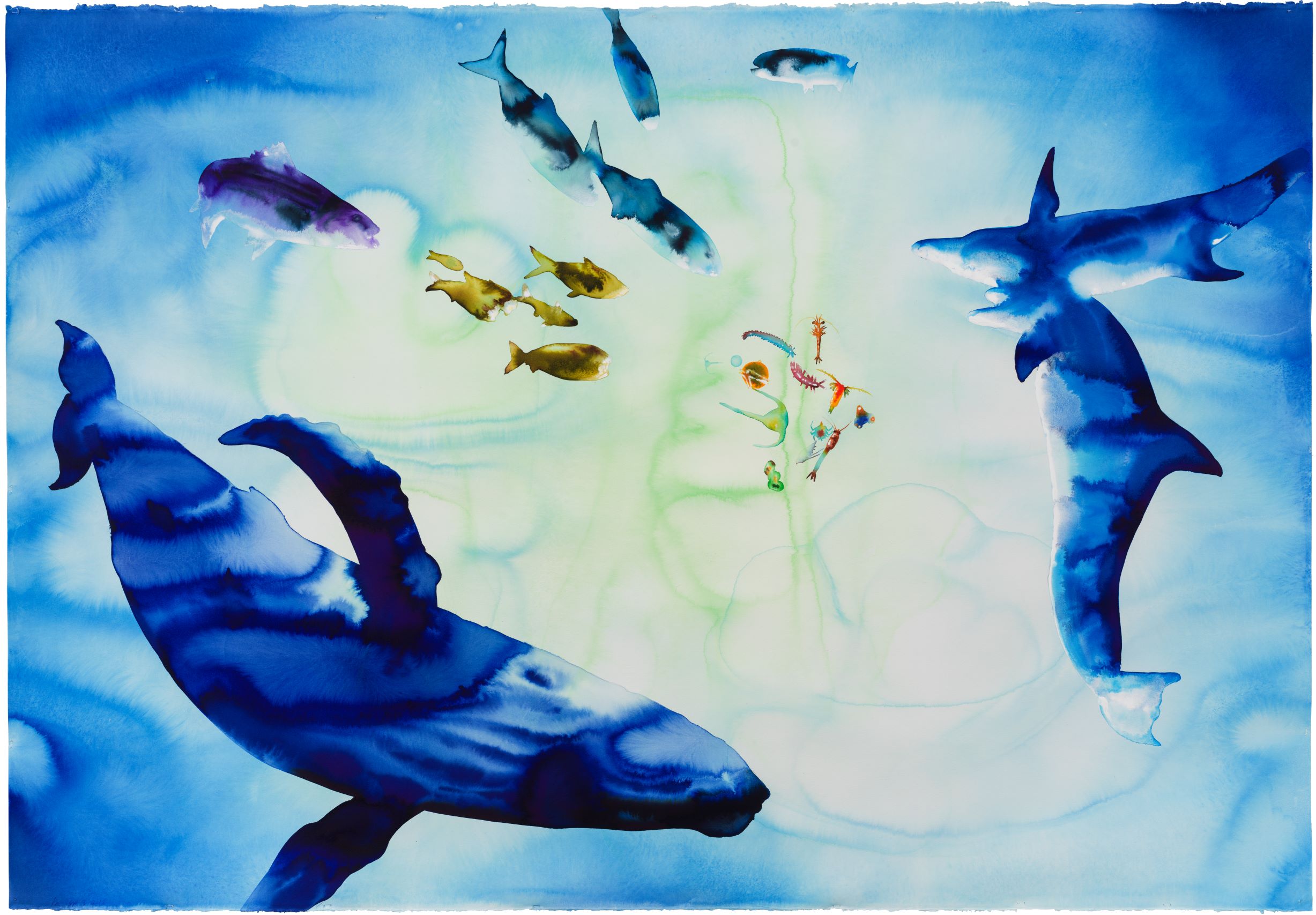
For its first contemporary art exhibition, “Alexis Rockman: Oceanus,” the Mystic Seaport Museum in Connecticut invited the environmental artist to work with its resident scientists and curators to create a series of 10 new watercolors inspired by the complexities of ocean life. The level of detail in each piece warrants close attention, and a key describes all the real-life species—both endangered and invasive—that are depicted, sometimes symbiotically stacked on top of each other.
At the center of the show is a monumental 24-foot-long canvas that explores the history of human interaction with the sea, from the first early sailors to travel in hand-hewn canoes to the football-field-sized container ships that throng international waterways today.
Working with maritime historians like Michael Harrison of the Nantucket Historical Association and the Seaport’s curator of collection Krystal Rose, Rockman created a visual timeline of maritime technologies and activities. Dramatically lit photos of historic ship models from the Mystic museum’s collection, as well as a native mishoon, or dugout canoe, loaned by the nearby Mashantucket Pequot Museum, were used as references for the painting.
“There are 18 of our boats in that painting,” Christina Connett Brophy, the institution’s senior director of museum galleries and senior vice president of curatorial affairs, told Artnet News. “But the models are not all the same scale—some of them are enormous, and some of them are really tiny. And so you see this magnificent big ship in the painting and realize the models are six inches long.”
Installation view of “Alexis Rockman: Oceanus” at the Mystic Seaport Museum in Connecticut. Photo: courtesy of Mystic Seaport Museum.
Each ship also carries its own important piece of history, from the famous slave ship Amistad, to the Thomas W. Lawson, a seven-masted cargo schooner that wrecked off the coast of Cornwall in the early 20th century, causing perhaps the first large-scale manmade oil spill.
But perhaps Rockman’s closest collaborator for the show is James Carlton, a global expert on invasive species. “He had something to do with most of the paintings, advising on different animals to include and how things move around,” Brophy said. One of the watercolors, in particular, titled Transient Passages, shows various marine life hitching a transoceanic ride on a plastic bottle.
“A few months after Alexis finished it, a big paper came out by Jim and several of his colleagues that look at the same themes,” Brophy added. “It proved that coastal creatures carried in water ballast and dumped in the middle of the Atlantic or the Pacific, where people think won’t survive because it’s not their habitat. They are doing just fine because of the plastic waste there.”
Installation view of “Alexis Rockman: Oceanus” at the Mystic Seaport Museum in Connecticut. Photo: courtesy of Mystic Seaport Museum.
Finding such a surprising note of optimism, in the face of environmental catastrophe, is an overall theme of the show, which also includes a side display on “blue technology,” or alternative maritime business models that are geared towards sustainability. Some examples include bio-plastics made from algae or designer shoe leather made from lionfish.
“What I love about this series is that some of the themes are really difficult—I mean, they are extinct and invasive species, and oil spills and all kinds of things that are pretty tough—but the paintings are so beautiful and colorful. They seem almost celebratory of the animals that they’re depicting,” Brophy said. “And there are really smart people out there in the world who are trying to find solutions, and they’re doing amazing work.”
Rockman and Brophy will attend a book signing for the exhibition catalog on World Oceans Day, June 8, at Rizzoli Bookstore, 1133 Broadway, New York.
See images of the exhibition, as well as Rockman working on the centerpiece for show, below.
Installation view of “Alexis Rockman: Oceanus” at the Mystic Seaport Museum in Connecticut. Photo: courtesy of Mystic Seaport Museum.
Alexis Rockman, Oceanus (2022).
Alexis Rockman, Benthos (2022).
Installation view of “Alexis Rockman: Oceanus” at the Mystic Seaport Museum in Connecticut. Photo: courtesy of Mystic Seaport Museum.
Alexis Rockman, Tsunami (2022).
Installation view of “Alexis Rockman: Oceanus” at the Mystic Seaport Museum in Connecticut. Photo: courtesy of Mystic Seaport Museum.
Alexis Rockman (center) with works from his “Oceanus” series in the studio.
Alexis Rockman working on the eight-by-24-foot panoramic oil painting Oceanus (2022). Photo: Adam Reich.
Alexis Rockman working on the eight-by-24-foot panoramic oil painting Oceanus (2022). Photo: Dorothy Spears.
Alexis Rockman working on the eight-by-24-foot panoramic oil painting Oceanus (2022). Photo: Dorothy Spears.
Alexis Rockman working on the eight-by-24-foot panoramic oil painting Oceanus (2022). Photo: Dorothy Spears.
Alexis Rockman working on the eight-by-24-foot panoramic oil painting Oceanus (2022). Photo: Dorothy Spears.
Alexis Rockman working on the eight-by-24-foot panoramic oil painting Oceanus (2022). Photo: Dorothy Spears.
“Alexis Rockman: Oceanus” is on view at the Mystic Seaport Museum, 75 Greenmanville Ave, Mystic, Connecticut, through next spring.